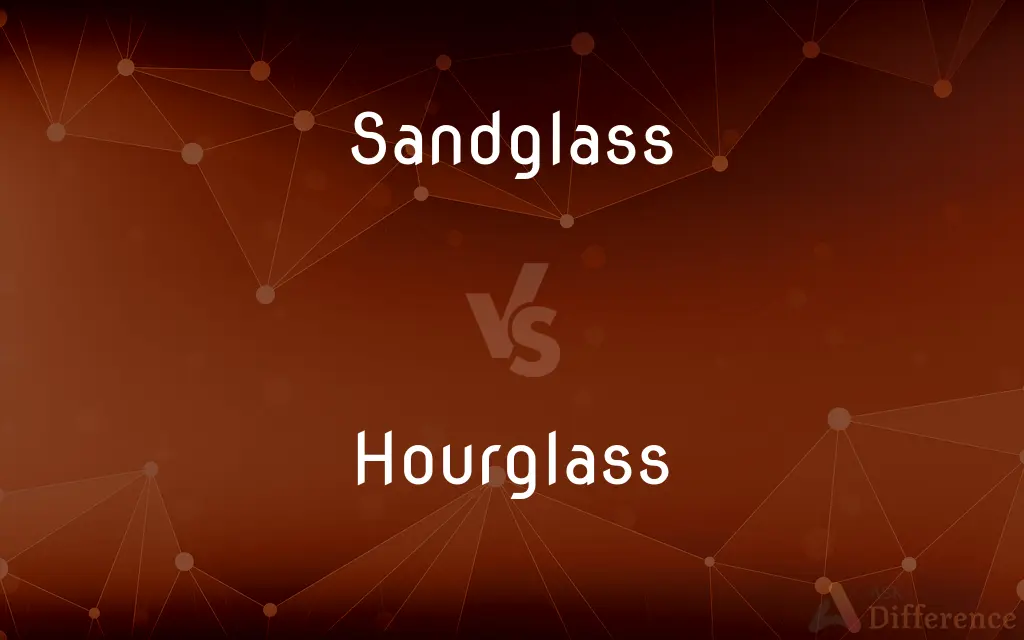Sandglass vs. Hourglass — What's the Difference?
By Urooj Arif & Fiza Rafique — Updated on March 30, 2024
An hourglass measures time through sand flow, while a sandglass can be any sand-based timer, not just hour-specific.

Difference Between Sandglass and Hourglass
Table of Contents
ADVERTISEMENT
Key Differences
An hourglass is a specific type of sandglass used for measuring time, traditionally set to one hour, where sand flows from an upper to a lower bulb through a narrow passage. On the other hand, a sandglass refers more broadly to any sand-based timer, which can measure different durations, not necessarily confined to one hour.
The term "hourglass" specifically denotes its primary use for tracking hours, a practice dating back centuries, particularly useful in navigation and ceremonial contexts. In contrast, "sandglass" is a more general term that encompasses a wider range of time-measuring devices using sand, regardless of the time span they cover, from minutes to hours.
Both devices operate on the same principle, where the flow of sand through a constriction accurately measures time. However, the design and size of an hourglass are typically standardized to measure an hour, whereas sandglasses can vary significantly in size and design based on the time they are meant to measure.
Hourglasses have a rich history and are often associated with symbolism related to the passage of time, mortality, and the transient nature of existence. Sandglasses, while similar in function, don’t carry the same weight of historical and cultural significance, being more utilitarian in nature.
Despite the differences in terminology and use, both hourglasses and sandglasses serve as reminders of the importance of time, offering a tangible representation of its passage. This makes them not only practical tools for timekeeping but also powerful metaphors in art, literature, and philosophy.
ADVERTISEMENT
Comparison Chart
Duration
Variable, not hour-specific
Typically 1 hour
Terminology
Broad, any sand timer
Specific to hours
Historical Use
General timekeeping
Navigation, rituals
Symbolism
General representation of time
Passage of time, mortality
Design
Varies by intended duration
Standardized for 1 hour
Compare with Definitions
Sandglass
Can be designed to measure various lengths of time, not limited to one hour.
A three-minute sandglass is often used in board games to limit turn time.
Hourglass
A device for measuring time, consisting of two glass bulbs connected by a narrow neck, filled with sand that flows from top to bottom in one hour.
The captain used an hourglass to time their navigational calculations at sea.
Sandglass
A generic term for any time-measuring device using sand, including hourglasses.
The cook used a small sandglass to time the boiling eggs.
Hourglass
Symbolically represents the passage of time and the inevitability of death.
An hourglass on a tombstone signifies the end of time for the deceased.
Sandglass
Versatile in application, from kitchen timers to game accessories.
Our kitchen sandglass helps ensure perfect timing for baking cookies.
Hourglass
Often found in board games as a timer to limit the duration of players' turns.
We flipped the hourglass to start the countdown for each chess move.
Sandglass
Less commonly used in modern symbolism or literature compared to the hourglass.
The artist's sculpture featured a broken sandglass, representing wasted time.
Hourglass
Represents an antiquated but visually impactful method of timekeeping.
The teacher used an hourglass to show students how people told time in the past.
Sandglass
Offers a visual and physical representation of time's passage, suitable for educational purposes.
In the science museum, a large sandglass demonstrated the concept of time to children.
Hourglass
Used in historical contexts for precise timekeeping before the advent of mechanical clocks.
Monks in medieval monasteries turned the hourglass to mark each hour of prayer.
Sandglass
An instrument for measuring the passage of time by the passage of sand through a narrow opening.
Hourglass
An hourglass (or sandglass, sand timer, sand clock or egg timer) is a device used to measure the passage of time. It comprises two glass bulbs connected vertically by a narrow neck that allows a regulated flow of a substance (historically sand) from the upper bulb to the lower one.
Sandglass
An instrument for measuring time by the running of sand. See Hourglass.
Hourglass
An instrument for measuring time, consisting of two glass chambers connected by a narrow neck and containing a quantity of sand, mercury, or another flowing substance that trickles from the upper chamber to the lower in a fixed amount of time, often one hour.
Sandglass
Timepiece in which the passage of time is indicated by the flow of sand from one transparent container to another through a narrow passage
Hourglass
Shaped like an hourglass
An hourglass design.
An hourglass figure.
Hourglass
A clock made of two glass vessels connected by a narrow passage through which sand flows.
Egg timer
After each game turn, invert the hourglass to reset the time limit for the next player.
Hourglass
(GUI) A cursor, often shaped like an hourglass, indicating that the computer is busy.
Hourglass
An instrument for measuring time, especially the interval of an hour. It consists of a glass vessel having two compartments, from the uppermost of which a quantity of sand, water, or mercury occupies an hour in running through a small aperture unto the lower.
Hourglass
A sandglass that runs for sixty minutes
Common Curiosities
Are hourglasses still used today?
While not commonly used for practical timekeeping, hourglasses serve as decorative items, educational tools, and symbols in art and literature.
Can a sandglass measure less than an hour?
Yes, sandglasses can be designed to measure any duration, from a few seconds to several hours, depending on the amount of sand and the size of the bulbs and neck.
Why were hourglasses important in navigation?
Hourglasses were crucial in navigation for keeping track of time at sea, which, along with celestial navigation, helped in estimating the ship's speed and position.
What is an hourglass?
An hourglass is a device used to measure the passage of time, typically consisting of two glass bulbs connected by a narrow neck that allows sand to flow from one to the other in exactly one hour.
What does the hourglass symbolize?
The hourglass is a powerful symbol of the passage of time, life’s transience, and the inevitability of death.
How do you reset an hourglass?
To reset an hourglass, simply turn it upside down so the sand begins to flow from the top bulb to the bottom one again.
How do sandglasses measure different times?
By varying the amount of sand, the size of the glass bulbs, and the narrowness of the connecting neck, sandglasses can be calibrated to measure different durations.
How does a sandglass differ from an hourglass?
A sandglass is a broader term for any sand-based timer, which can measure various durations, not specifically one hour, whereas an hourglass is designed to measure exactly one hour.
Can sandglasses be considered accurate?
Sandglasses can be very accurate for the time they are designed to measure, although their accuracy can be affected by factors like the sand's grain size and the ambient humidity.
What kinds of sand are used in sandglasses?
Sandglasses typically use specially graded sand or fine powdered minerals that flow steadily and predictably.
What lessons can we learn from hourglasses and sandglasses?
Both hourglasses and sandglasses remind us of the importance of time management, the finite nature of our lives, and the value of each moment.
Were sandglasses used before mechanical clocks?
Yes, sandglasses were among the earliest timekeeping devices, used before the widespread adoption of mechanical clocks.
How are hourglasses made?
Hourglasses are made by crafting two glass bulbs connected by a narrow passage, then filling one bulb with a specific amount of sand that flows through to the other bulb in a set time.
Do all cultures use hourglasses to represent time?
While the hourglass is a widely recognized symbol of time, different cultures have their own symbols and devices for representing and measuring time.
Can an hourglass be repaired if broken?
Repairing an hourglass can be challenging and may require specialized glassworking skills to seal the bulbs and ensure accurate time measurement.
Share Your Discovery

Previous Comparison
Hence vs. Since
Next Comparison
Old vs. ElderlyAuthor Spotlight
Written by
Urooj ArifUrooj is a skilled content writer at Ask Difference, known for her exceptional ability to simplify complex topics into engaging and informative content. With a passion for research and a flair for clear, concise writing, she consistently delivers articles that resonate with our diverse audience.
Co-written by
Fiza RafiqueFiza Rafique is a skilled content writer at AskDifference.com, where she meticulously refines and enhances written pieces. Drawing from her vast editorial expertise, Fiza ensures clarity, accuracy, and precision in every article. Passionate about language, she continually seeks to elevate the quality of content for readers worldwide.















































